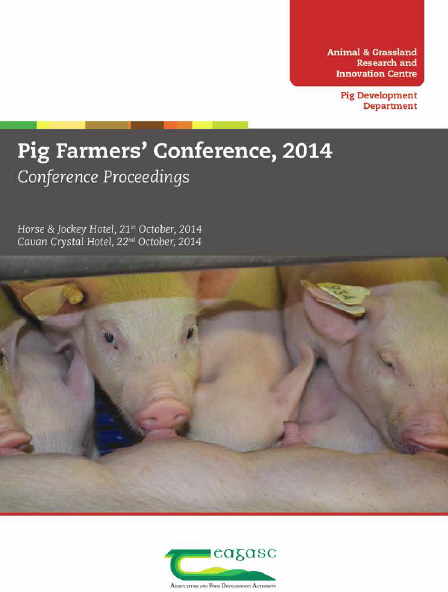



Composting Dead Pigs
Amy Quinn and Ciaran Carroll of Teagasc explored the options for composting and presented their findings at the 2014 Pig Farmers Conference.
Currently within the European Union, the composting of dead pigs is not permitted. The cost of dead pig disposal, however, has risen to a level where it is now a significant cost for all pig producers (€200 to 300 per tonne). Therefore it may be the time to consider composting as an alternative strategy for disposing of pig carcasses.
The use of composting as a carcass disposal method is widely used outside of the EU. Other EU member states have investigated the potential of composting and the future legislative changes required.
Research to date has identified that there is no evidence that the product of composting pig and poultry carcasses poses any greater public threat than general food waste.
What Are the Benefits?
Composting of pigs as opposed to rendering is a relatively low-cost method of carcass disposal and could result in substantial savings. While switching to composting would require and initial investment in facilities the subsequent maintenance/ labour cost of these facilities is low.
In cases where a bulking agent (dry organic material, e.g dry straw, sawdust, wood shavings and manure) is not freely available, there is an additional cost of purchasing it. It is estimated that the initial facilities cost would be paid off in a year and a half.
In the US and Canada, the final composted product can be used as a valuable soil amendment or organic fertiliser. The European Food Safety Authority, however, currently considers the composted product still to be an animal by-product and thus must be disposed of through incineration due to the perceived risk to the food chain due to pathogen survival during composting.
Additionally composting on farm would eliminate the bio-security risk posed by collection trucks and may reduce the storage time of dead pigs on farm before disposal/collection.
In addition, if diseased pigs are present on a unit, on-site composting will aid the prevention of disease spreading.
How Does Composting Work?
Composting is a natural biological process whereby microorganisms breakdown/ decompose organic materials by aerobic (requires oxygen) decomposition. This process can be used to break down animal carcasses by controlling the environmental conditions required.
Carcass composting uses organic by-products, such as dead pigs, straw or sawdust, and converts them into odourless, inoffensive, generally pathogen-free product that can be used as a soil amendment or organic fertilizer or alternatively may be incinerated, depending on governing legislation. It is very similar to composting garden waste. Microorganisms consume oxygen and feed on the organic substrates to produce carbon dioxide, water, heat and a stabilised organic matter called humus. The speed and efficiency of this aerobic process depends on the temperature, nutrients, moisture, oxygen availability and particle size.
Temperature
A temperature of 55°C is optimum for both the composting process and for destroying pathogens and should be regularly monitored throughout the composting phases as it acts as an indicator that the composting is progressing well. In North Carolina, research compost piles reaching temperatures of over 55°C, killed off most of the Salmonella and all of the Erysipelas in the compost pile.
Nutrients
Carbon and nitrogen are the most important nutrients required for composting. Common carbon sources could include dry sawdust, wood shavings manure and straw. The primary nitrogen source is the pig carcasses themselves. A carbon:nitrogen ratio between 25:1 and 30:1 is optimal. Phosphorus, sulphur, calcium and trace amounts of other nutrients are also required, however, usually adequate amounts are found in the carcasses and carbon source.
Moisture
A moisture content of 40 to 60 per cent is optimal. Too much (more than 60 per cent) or too little (less than 40 per cent) moisture hampers microbe activity. If too dry, water or liquid manure will need to be added and if too wet the source of water entry needs to be eliminated.
Oxygen
Decomposition occurs fastest in fully aerobic conditions (oxygen present). However, over time aerobic conditions probably exist only at the periphery of the compost piles commonly constructed. Therefore, operators must mechanically aerate the piles periodically by turning the pile.
Particle size
The smaller the particle sizes of the carcass, the greater the surface area available on which micro-organisms can work. However, in practice, pig carcasses need not be cut into smaller pieces; larger carcasses will however take longer to break down.
Facilities
The facilities required vary but are generally basic in structure. The structures are required to be water- and rodent-proof. Often a bin system is used which is similar to a silage pit type structure with several bays enclosed within a shed, protected from wildlife and rain.
The capacity of the facilities should contain a buffer so that it can handle a rise in mortalities as a result of disease outbreak, for example.
The composting occurs within the bays, where layers of bulking agents (carbon source) and carcasses are held. Firstly there is an initial layer of a dry organic material bulking agent (approximately 24 inches). Next, on top of this layer, leaving a two foot margin at the edge of the pile, the carcasses are positioned. Following this, another two-foot layer of bulking agent is positioned on top of the carcass layer and this pattern repeats until the bay is appropriately full. Once the layers are complete the pile is sealed off with sawdust or previously composted material to prevent odours and rodents.
A crucial step in composting is monitoring the temperature to see how the composting process is progressing. In practice, the piles are turned two to three days after temperature peaks and again after two to four months if composting is not complete as turning the pile will provide air to complete the process and cover it with a bulking agent to allow the process to finish. Turning aerates the pile and restarts the decomposition process.
Although this process is not permitted in the EU at present, with current disposal costs running so high, perhaps this low-cost option should be further investigated with a view to making it acceptable in the EU.
Reference
Quinn A. and C. Carroll. 2014. Composting dead pigs. Proceedings of the Teagasc Pig Farmers' Conference 2014. 21 and 22 October 2014. p60-62.
Further Reading
You can view other papers from the 2014 Teagasc Pig Farmers Conference by clicking here.
February 2015








